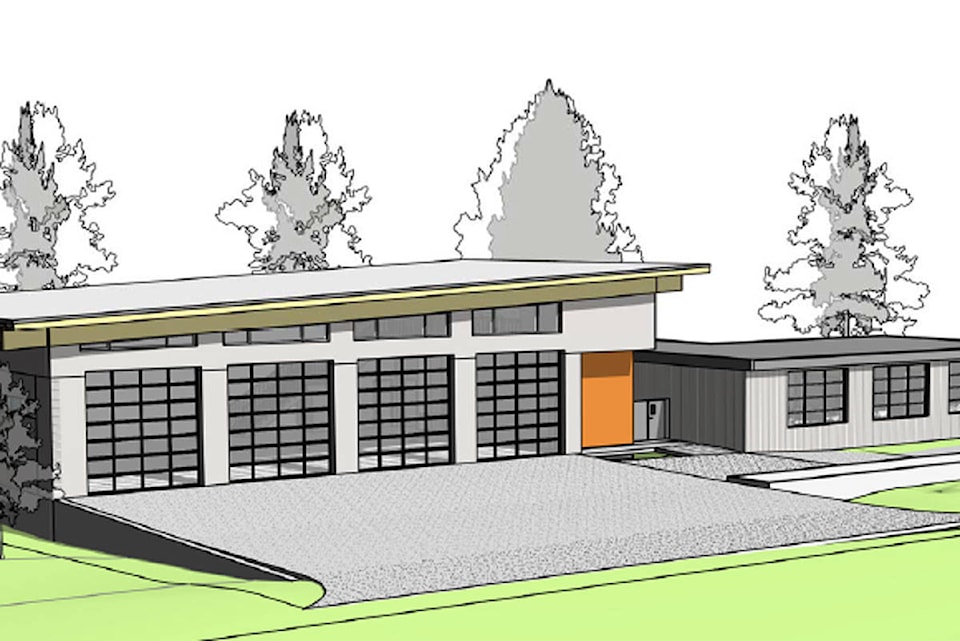North Oyster Fire Department is receiving a belated gift for its 60th anniversary, a long anticipated new fire hall built on a neighbouring parcel of land and a retrofit of the existing facility.
“I’m absolutely thrilled,” CVRD Area H director Mary Marcotte told the Chronicle. “Over the last number of years we have put the reserves in place and I’ve heard only one person say a negative about it since that time.”
The volunteer fire department celebrated 60 years servicing the community last summer.
Approximately $2.3-million of the total $2.7-million project cost is from reserves, including Gas Tax funding, while the remaining amount will come from short-term debt.
The debate, however, has raged on for over a decade among residents of the rural community over how to best pay for a new building on Yellow Point Road.
RELATED: North Oyster fire hall vote could get hot
A referendum defeated in late 2011 asked the community if they were in favour of borrowing up to $3,030,000 to build a three-bay replacement fire hall in North Oyster and a new two-bay hall at Coffin Point.
Prior to that, an ad-hoc citizens committee was set up in 2009 to review the proposed fire hall replacement after a 2007 proposal to build one fire hall was also defeated by the public.
Finally earlier this year, the CVRD was able to raise the maximum requisition limit by 25 per cent, setting it at the greater of $554,472 or 0.87999/1000 of net taxable value. Funds were also added to the CVRD’s reserves over several years through efficiencies found in the operations of the fire department.
A half-acre was recently purchased directly adjacent to the existing fire hall helping to facilitate the new expansion which got underway recently.
“At the end of the day the public was satisfied. It’s badly needed,” Marcotte added. “I think it’s going to be a very huge asset for the community as a whole because the fire department does so much more than just fight fires. I think it’s a very important step and will be something I’m sure that the residents appreciate.”
Last year, the North Oyster Fire Department responded to 200 calls, the busiest the crew of volunteers has been in the past four years.
The CVRD’s Fire Protection Service Coordinator and former North Oyster fire chief of almost two decades, Jason deJong said there have been some upgrades to the building since the mid-60s but now North Oyster has quite literally outgrown its hall.
“There’s only three apparatus truck bays that are pretty tiny, especially for modern trucks. The training room is extremely small, all the office administrative areas are extremely small,” he said.
Bay doors on the existing building are 10 feet versus 14 feet on the new one.
“The new building will have have an additional bay that will house a fire truck already in storage…and we’re attaching (the building) to the original hall and it will undergo a major renovation.”
It’s not unheard of right now for firefighters to have pull out the trucks and train on the dirty floor, or cram into a small room for meetings.
The new facility has a place for gear storage, shower facilities, radios, computers and perhaps most importantly somewhere to rest after returning from more demanding response calls.
The existing facility will have a new floor plan for offices and training as well as a revamp on the outside.
One of the major outstanding issues will be how to properly service Shell Beach Road which extends outside of the 8 kilometre fire underwriters response.
“We’ve concentrated our efforts back on looking after the main station first now and then we’ll in the near future probably tackle the fire service delivery down at Shell Beach as well,” deJong said.
At the far end of Elliot Beach is 12.5 kilometres away from the fire hall which translates into a 17 minute drive time.
Marcotte also said a second satellite station would be needed in the future.
“We definitely need to do that because there’s one way in and one way out unless you have a boat you can hop in,” she said. “You’ve got lots of infrastructure there that the First Nations have put in there.”
Look for the fire hall to be complete by later this year with the full project wrapping up early next spring.
